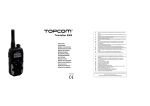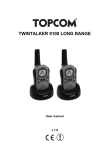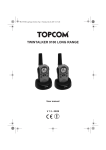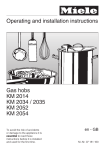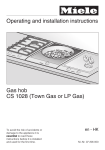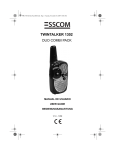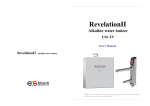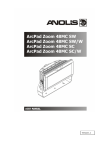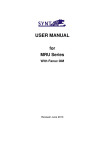Download Major tech MTD90 User guide
Transcript
MTD90 LICENCE FREE 2-WAY RADIOS USER GUIDE MTD90 MTD90 MTD90 LICENCE FREE 2-WAY RADIOS ILLUSTRATION Page 1 MTD90 LICENCE FREE 2-WAY RADIOS 1 Introduction Thank you for purchasing the MTD90. It’s a long range, low powered radio communication device with a range of maximum 10 Km. It has no running costs other than the minimal cost of re-charging the batteries. The MTD90 operates on 8 channels. 2 Intended purpose It can be used for recreational purposes. For example: to keep in contact during travelling with 2 or more cars and cycling. Widely used for building sites and to keep in contact with your children when they are playing outside, etc... 3 CE Mark The CE symbol on the unit, user guide and giftbox indicates that the unit complies with the essential requirements of the R&TTE directive 1995/5/EC. 4 Safety instructions 4.1 General Please read carefully through the following information concerning safety and proper use. Make yourself familiar with all functions of the device. Keep this manual in a safe place for future use. 4.2 Burning injuries • If the cover of the antenna is damaged, do not touch because when an antenna comes in contact with the skin, a minor burn may result when transmitting. • Batteries can cause property damage such as burns if conductive material such as jewellery, keys or beaded chains touches exposed terminals. The material may complete an electrical circuit (short circuit) and become quite hot. Exercise care in handling any charged battery, particularly when placing it inside a pocket, purse or other container with metal objects. 4.3 Injuries • Do not place your device in the area over an air bag or in the air bag deployment area. Air bags inflate with great force. If a PMR is placed in the bag deployment area and the air bag inflates, the communicator may be propelled with great force and cause serious injury to the occupants of the vehicle. • Keep the PMR at least 15 centimetres away from a pacemaker. • Turn your PMR OFF as soon as interference is taking place with medical equipment. 4.4 Danger of explosion • Do not replace batteries in a potentially explosive atmosphere. Contact sparking may occur while installing or removing batteries and cause an explosion. • Turn your PMR off when in any area with a potentially explosive atmosphere. Sparks in such areas could cause an explosion or fire resulting in bodily injury or even death. • Never throw batteries in fire as they may explode. Page 2 MTD90 LICENCE FREE 2-WAY RADIOS Areas with potentially explosive atmospheres are often, but not always, clearly marked. They include fuelling areas such as below deck on boats, fuel or chemical transfer or storage facilities; areas where the air contains chemicals or particles, such as grain, dust or metal powders; and any other area where you would normally be advised to turn off your vehicle engine. 4.5 Poisoning danger • Keep batteries away from small children. 4.6 Legal • In some countries it is prohibited to use your PMR while driving a vehicle. In this case leave the road before using the device. • Turn your PMR OFF when on board an aircraft when instructed to do so. Any use of the PMR must be in accordance with airline regulations or crew instructions. • Turn your PMR OFF in any facilities where posted notices instruct you to do so. Hospitals or health care facilities may be using equipment that is sensitive to external RF energy. • Replacing or modifying the antenna may affect the PMR radio specifications and violate the CE regulations. Unauthorised antennas could also damage the radio. 4.7 Notes • Do not touch the antenna while transmitting, it could affect the range. • Remove the batteries if the device is not going to be used for a long period. 5 Cleaning and maintenance • • • To clean the unit, wipe with a soft cloth dampened with water. Don’t use a cleaner or solvents on the unit; they can damage the case and leak inside, causing permanent damage. Battery contacts may be wiped with a dry lint-free cloth. If the unit gets wet, turn it off and remove the batteries immediately. Dry the battery compartment with a soft cloth to minimize potential water damage. Leave the cover off the battery compartment overnight or until completely dry. Do not use the unit until completely dry. 6 Disposal of the device (environment) At the end of the product lifecycle, you should not throw this product into the normal household garbage but bring the product to a collection point for the recycling of electrical and electronic equipments. The symbol on the product, user guide and/or box indicate this. Some of the product materials can be re-used if you bring them to a recycling point. By re-using some parts or raw materials from used products you make an important contribution to the protection of the environment. Please contact your local authorities in case you need more information on the collection points in your area. Page 3 MTD90 LICENCE FREE 2-WAY RADIOS 7 Using a PMR device To communicate between PMR devices they need to be set all on the same channel and CTCSS / DCS code (see chapter “13.7 CTCSS (Continious Tone Coded Squelch System) / DCS (Digital Coded Squelch)” and within receiving range (up to max. 10 km in open field). Since these devices use free frequency bands (channels), all devices in operation share these channels(total 8 channels). Therefore, privacy is not garanteed. Anybody with a PMR set to your channel can overhear the conversation. If you want to communicate (transmitting a voice signal) you need to press the PTT-button 12 . Once this button pressed, the device will go into transmit mode and you can speak into the microphone. All other PMR devices in range , on the same channel and in standby mode (not transmitting) will hear your message. You need to wait until the other party stops transmitting before you can reply to the message. At the end of each transmission the unit will send a beep if the Roger Beep is enable (see chapter “13.12 Roger Beep On/Off” ). To reply, just press the PTT-button 12 and speak into the microphone. If 2 or more users press the PTT-button 12 at the same time the receiver will receive only the stongest signal and the other signal(s) will be supressed. Therefore you should only transmit a signal (press PTT-button 12 when the channel is free. The range of radio waves is strongly affected by obstacles such as buildings, concrete/metal structures, the unevenness of the landscape, woodland, plants, … This implies that the range between two or more PMR's may in some extreme cases be restricted to a maximum of a few tens of meters. You will soon notice that PMR works best when there is a minimum of obstacles between users. 8 Included in the package • • • • • 2 x MTD90 2 x Desktop Charger 2 x Power adapter 8 x AAA NiMh batteries User guide Page 4 MTD90 LICENCE FREE 2-WAY RADIOS 9 Getting started 9.1 Installing/Removing the Belt Clip 1. To remove the belt clip from the unit, push the belt clip (B) towards the antenna, while pulling the clip tab (A). 2. When re-installing the belt clip, a click indicates the belt clip is locked into position 9.2 Battery Installation 1. Remove the belt clip (see chapter “9.1 Installing/Removing the Belt Clip”) 2. Lift the battery door by gently pushing the door clip (C) using your finger nail. 3. Install the NiMh batteries. Make sure that the polarity of the NiMh batteries is correct. 4. Close the battery door. 5. Re-install the belt clip Page 5 MTD90 LICENCE FREE 2-WAY RADIOS 10 Charging the batteries There are two ways to charge the battery of the PMR's : 10.1 Using the desktop charger The desktop charger provides drop-in charging convenience. 1. Put the desktop charger on a flat surface. 2. Plug one end of the supplied adapter into an easy accessible electric socket and the other end into the connector on the backside of the desktop charger 28 (See Page 1 - illustration 3) 3. Put the radio in the charger as indicated. 4. The charging LED 29 will turn on if it’s properly inserted and charging. (See Page 1 - illustration 3) 10.2 Connecting the power adapter directly to the PMR 1. Connect the connector of the power adapter directly to the charger connection 3 of the PMR. It will take about 8 to 10 hours to fully charge the batteries. Do not press the PTT-Button 12 of the PMR’s while they are charging ! Do not short-circuit the batteries or dispose in fire. Remove the batteries if this device is not going to be used for a long period. Do not charge non rechargeable batteries like Alkaline batteries in the charger. This might damage the PMR’s and charger unit. Page 6 MTD90 LICENCE FREE 2-WAY RADIOS 11 Description (See Page 1 - illustration 3) 1. 2. 3. 4. 5. 6. ON/OFF Volume knob LCD display Charger connection Headset connection TX LED ( on when transmitting) Call button 7. Menu button – Enter the menu settings Microphone Speaker Down button – Select previous value in the menu Up button – Select next value in the menu PTT-button Antenna See folded cover page - illustration 3 Charger connection Charger LED ( on when charging) 8. 9. 10. 11. 12. 13. 28. 29. 12 LCD display information (See Page 1 - illustration 2) 14. 15. 16. 17. 18. 19. 20. 21. 22. 23. 24. 25. 26. 27. CTCSS indication DCS indication CTCSS/DCS value Frequency indication in MHz MHz indication Keypad lock icon Call receive type indication Battery level indication Channel number RX icon – Displayed when receiving TX icon – Displayed when transmitting VOX indication Scanning indication Dual channel mode (DCM) indication Page 7 MTD90 LICENCE FREE 2-WAY RADIOS The display illustrations in next pages only show the icons or display informations of the functions that are explained in the text. 13 Using the MTD90 13.1 Switching On/Off the PMR radio • Turn the “On-Off/Volume Knob” 1 clockwise. A clicking sound will indicate that the PMR radio is switched on. • Turn the “On-Off/Volume Knob” 1 fully counter clockwise. The clicking sound will indicate that the PMR radio is switched off. 13.2 Battery Charge Level/Low Battery Indication The battery charge level is indicated by the number of squares present inside the battery icon on the LCD Screen. Battery Full Battery 2/3 charged Battery 1/3 charged Battery empty When the battery charge level is low, the battery icon will flash and a beep will be heard to indicate that the batteries need to be replaced or recharged. 13.3 Adjusting Speaker Volume • Turn the “On-Off/Volume Knob” 1 clockwise to increase the speaker volume. • Turn counter-clockwise to lower the volume. 13.4 Receiving a Signal The unit is continuously in the receive mode when the unit is switched ON and not transmitting. In order for other people to receive your transmission, they must also be on the same channel and have set the same CTCSS code or DCS code. (See chapter “13.6 Changing Channels” and “13.7 CTCSS (Continues Tone Coded Squelch System) / DCS (Digital Coded Squelch)”. Either CTCSS or DCS can be used but never both at the same time. Page 8 MTD90 LICENCE FREE 2-WAY RADIOS 13.5 Transmitting a Signal • Press and hold the PTT - button 12 to transmit. The TX symbol is displayed. • Hold the unit in a vertical position with the microphone 10cm from the mouth and speak into the microphone. • Release the PTT - button 12 when you want to stop transmitting. To check the channel activity use the monitor function (See chapter “13.8 Monitor”). 13.6 Changing Channels • Press the - button 7 once, the current channel number flashes on the display. • Press the - button or the - button 10 to change the channel. • Press the PTT - button 12 to confirm and return to stand-by mode. If no button is pressed within 5 seconds during setting, the unit will return to standby. 13.7 CTCSS (Continious Tone Coded Squelch System) / DCS (Digital Coded Squelch) License free PMR radio's operating on the 446 MHz frequency band, like the MTD90 PMR, have 8 available radio channels. If there are many PMR users in your neighborhood, there is a chance that some of these users are operating on the same radio channel. To prevent that you receive signals from other users, sub-channels have been integrated. Two PMR radio's will only be able to communicate with each other when they are operating on the same radio channel and when they have selected exactly the same sub-channel. There are two kind of sub-channels : • Continuous Tone Coded Squelch System (CTCSS) • Digital Coded Squelch (DCS) When using CTCSS, a low frequency tone (between 67 and 250 Hz) will be transmitted along with the voice signal. There are 38 available tones to choose from. You are free to choose one of these 38 available tones. Due to filtering, these tones will generally not be audible so they will not disturb the communication. DCS is similar to CTCSS, but instead of sending a continuous tone of a selected frequency, a digital data transmission is added to the radio signal. This Digital Code is transmitted at a really low rate, around 134 bits per second (the code is 23 bits long). Only the PMR's of the latest generation will support DCS. There are 83 available DCS codes that can be used. Since earlier models will only support CTCSS it will be better to use DCS to Page 9 MTD90 LICENCE FREE 2-WAY RADIOS PTT PTT To disable CTCSS or DCS, select code "00" for CTCSS or for DCS in the menu. When the entry is confirmed, "OF" will be displayed. During channel monitoring the receiver circuit in the PMR will not listen to CTCSS or DCS codes. The PMR is capable of voice activated (VOX) transmission. In VOX mode, the radio will transmit a signal when it is activated by your voice or other sound around you. VOX operation is not recommended if you plan to use your radio in a noisy or windy environment. VOX mode will be overrided when you press the PTT - button 12 . Page 10 MTD90 LICENCE FREE 2-WAY RADIOS PTT If you press the PTT - button 12 while listening to a found channel, the PMR will go back in stand-by mode on the found channel. PTT Page 11 MTD90 LICENCE FREE 2-WAY RADIOS • • If you press the PTT - button while listening to a found CTCSS code, the PMR will go back in stand-by mode on the channel with the CTCSS code. If no CTCSS code is detected there is a chance that DCS is selected by the user. In this case you can scan for the DCS code. (section 13.10.3) If you press the PTT - button 12 while listening to a found DCS code, the PMR will go back in stand-by mode on the channel with the DCS code. The MTD90 has 15 call tones PTT PTT Page 12 MTD90 LICENCE FREE 2-WAY RADIOS PTT PTT Page 13 MTD90 LICENCE FREE 2-WAY RADIOS PTT PTT PTT PTT PTT Page 14 MTD90 LICENCE FREE 2-WAY RADIOS Page 15 MTD90 Cnr Rover and Jaguar Roads, Rustivia Ext. 3, Elandsfontein P.O. Box 888, Isando 1600 South Africa LICENCE FREE 2-WAY RADIOS CONTACT DETAILS Telephone: +27 11 822 1551 Sales Facsimile: +27 11 822-2806 E-mail: [email protected] National Tel Nr: 08 61 62 5678 Website: www.major-tech.com Page 16

















